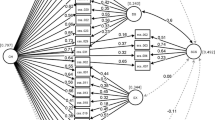Abstract
Armstrong et al. (International Journal of Human Computer Studies, 53:537–550, 2000) explored the relationship between problematic Internet use and self-esteem. They devised a questionnaire called the Internet Related Problem Scale (IRPS) in order to measure the level of problem an individual is having due to their Internet use. This questionnaire study further examined the psychometric properties of the IRPS. Participants were recruited through the Internet, yielding 79 valid responses (14 males and 65 females). Factor analysis of the IRPS revealed six factors—salience, negative effects, mood enhancement, productivity, loss of control, and lack of information. These factors showed good internal consistency and concurrent validity, with salience being the most reliable. The limitations to this study are also addressed. Despite these limitations, the findings do seem to suggest that the IRPS has good psychometric properties and can be used in future studies examining Internet addiction.
Similar content being viewed by others
References
Armstrong, L., Phillips, J. G., & Saling, L. L. (2000). Potential determinants of heavier internet usage. International Journal of Human Computer Studies, 53, 537–550.
Azar, B. (2000). Online experiments: Ethically fair or foul? Monitor on Psychology, 3(4), 50–52.
Brenner, V. (1997). Psychology of computer use: XLVII. Parameters of internet use, abuse and addiction: The first 90 days of the internet usage survey. Psychological Reports, 80, 879–882.
Caplan, S. E. (2003). Preference for online social interaction: A theory of problematic Internet use and psychosocial well-being. Communication Research, 30, 625–648.
Coopersmith, S. (1981). The antecedents of self-esteem. Palo Alto: Consulting Psychologists.
Greenberg, J., Lewis, S., & Dodd, D. (1999). Overlapping addictions and self-esteem among college man and woman. Addictive Behaviors, 24, 565–571.
Griffiths, M. D. (2000). Does internet and computer “addiction” exist? Some case study evidence. CyberPsychology and Behavior, 3, 211–218.
Hathaway, S. R., & McKinley, J. C. (1989). Minnesota multiphasic personality inventory-2: Manual for administration and scoring. Minneapolis: University of Minnesota Press.
Krantz, J., Ballard, J., & Scher, J. (1997). Comparing the results of laboratory and World Wide Web samples of the determinants of female attractiveness. Behaviour Research Methods, Instruments and Computers, 29, 264–268.
Kraut, R., Patterson, M., Landmark, V., Kiesler, S., Mukophadhyay, T., & Scherlis, W. (1998). Interenet paradox: A social technology that reduces social involvement and psychological well being? American Psychologist, 53, 1017–1031.
Lavin, M., Marvin, K., McLarney, A., Nola, V., & Scott, L. (1999). Sensation seeking and collegiate vulnerability to Internet dependence. CyberPsychology and Behavior, 2, 425–430.
Morahan-Martin, J., & Schumacher, P. (2000). Incidents and correlates of pathological Internet use among college students. Computers in Human Behavior, 16, 13–29.
Niemz, K., Griffiths, M. D., & Banyard, P. (2005). Prevalence of pathological internet use among university students and correlations with self-esteem, GHQ and disinhibition. CyberPsychology and Behavior, 8, 562–570.
Petrie, H., & Gunn, D. (1998). Internet “Addiction”: The Effects of Sex, Age, Depression and Introversion. Paper presented at the British Psychological Society Conference, London (December).
Smith, M., & Leigh, B. (1997). Virtual subjects: Using the Internet as an alternative source of subjects and research environment. Behaviour Research Methods, Instruments and Computers, 29(4), 496–505.
Wästlund, E., Norlander, T., & Archer, T. (2001). Internet blues revisited: Replication and extension for an Internet paradox study. CyberPsychology and Behavior, 4, 385–391.
Widyanto, L. & Griffiths, M. D. (2006). Internet addiction: A critical review. International Journal of Mental Health and Addiction, 4, 31–51.
Young, K. (1996). Internet addiction: The emergence of a new clinical disorder. CyberPsychology and Behavior, 3, 237–44.
Young, K. S., & Rodgers, R. C. (1998). The relationships between depression and Internet addiction. CyberPsychology and Behavior, 1, 25–28.
Zuckerman, M. (1979). Sensation seeking and risk taking. In C. E. Iazard (Ed.), Emotions in personality and psychopathology (pp. 163–197). New York: Plenum.
Author information
Authors and Affiliations
Corresponding author
Rights and permissions
About this article
Cite this article
Widyanto, L., Griffiths, M., Brunsden, V. et al. The Psychometric Properties of the Internet Related Problem Scale: A Pilot Study. Int J Ment Health Addiction 6, 205–213 (2008). https://doi.org/10.1007/s11469-007-9120-6
Received:
Accepted:
Published:
Issue Date:
DOI: https://doi.org/10.1007/s11469-007-9120-6




